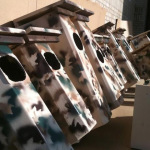Did you know that GM cares about bats and other threatened species? Well they do and they even have a person on the payroll to think up creative ways to use what others would call waste products created by manufacturing of their products. His name is John Bradburn and holds the title of GM global manager of waste reduction. GM also currently has 122 landfill-free facilities.
Researchers say that more than 5.7 million bats in the United States and Canada have contracted and died from, white-nose syndrome, a deadly fungus appearing on the muzzle and other parts of hibernating bats. Bats with the disease act abnormally and wake from hibernation too frequently, leading to death.
There is no cure for white-nose syndrome, but remedies like nontoxic fungicides and artificial bat caves show promise. Saving bats is important because they contribute to the overall health of the environment. A single bat eats up to 5,000 insects a night, which means farmers can use fewer pesticides. They are also pollinators that help repopulate plants and maintain forests.
“We need to do what we can to prevent more bats from contracting white-nose syndrome while they are hibernating,” said Rob Mies, executive director for the Organization for Bat Conservation. “Researchers are working around the clock to find a way to stop the transmission from occurring in caves. This disease is occurring at a rapidly escalating rate and if a solution is not found soon, many bat species could face extinction.”
So where does GM come into the picture? It turns out that an adhesive used in production of the 2015 Chevrolet Corvette Stingray may help preserve the threatened bat species in North America. The adhesive can serve as an artificial stalactite in bat caves. Creation of the stalactite is simple; robots that apply a structural adhesive that helps join Corvette body parts are purged regularly to keep the adhesive applicator clean and free of dried material. This dried gunk is the perfect shape for a stalactite, and its use in artificial bat caves avoids sending it to landfills.
Bat projects have been a part of GM for several years, examples of GM’s industry-leading 26 certified wildlife habitat programs and penchant for creative recycling.
The company also creates bat houses out of scrap Chevrolet Volt battery covers that can hold up to 150 little brown bats each. John Bradburn, GM global manager of waste reduction, came up with the reuse idea, transforming the difficult-to-recycle material into nesting structures. So far, 232 of these bat houses have been installed on its properties and in other private and public lands in the United States. A tweak of the design has led to 368 specially designed structures to serve wood ducks, owls, bluebirds and scaly-sided mergansers – an endangered species.
